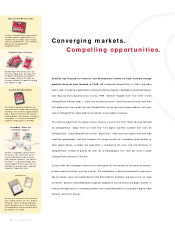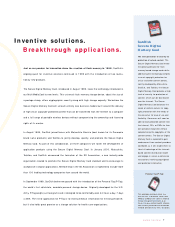SanDisk 1999 Annual Report Download - page 15
Download and view the complete annual report
Please find page 15 of the 1999 SanDisk annual report below. You can navigate through the pages in the report by either clicking on the pages listed below, or by using the keyword search tool below to find specific information within the annual report.
12 Annual Report 1999
MANAGEMENT’S DISCUSSION AND ANALYSIS
OF FINANCIAL CONDITION AND RESULTS OF OPERATIONS
Overview
SanDisk was founded in 1988 to develop and market flash data
storage systems. We sell our products to the consumer electronics
and industrial/communications markets. In 1999, the percentage of
our product sales attributable to the consumer electronics market,
particularly sales of CompactFlash for use in digital camera appli-
cations, continued to grow. This increase in sales to the consumer
market resulted in a further shift in sales mix to products with aver-
age capacities between 8 and 64 megabytes, which typically have
lower average selling prices and gross margins than our higher
capacity FlashDisk and FlashDrive products. In addition, a substan-
tial portion of our CompactFlash products are sold into the retail
channel, which usually has shorter customer order lead-times than
our other channels. A majority of our sales to the retail channel are
turns business, with orders received and fulfilled in the same quar-
ter, thereby decreasing our ability to accurately forecast future
production needs. We believe sales to the consumer market will con-
tinue to represent a majority of our sales as the popularity of
consumer applications, including digital cameras, increases.
Our operating results are affected by a number of factors including
the volume of product sales, availability of foundry capacity, varia-
tions in manufacturing cycle times, fluctuations in manufacturing
yields and manufacturing utilization, the timing of significant
orders, competitive pricing pressures, our ability to match supply
with demand, changes in product and customer mix, market accept-
ance of new or enhanced versions of our products, changes in the
channels through which our products are distributed, timing of new
product announcements and introductions by us and our competi-
tors, the timing of license and royalty revenues, fluctuations in
product costs, increased research and development expenses, and
exchange rate fluctuations. In addition, as the proportion of our
products sold for use in consumer electronics applications
increases, our revenues may become subject to seasonal declines in
the first quarter of each year. See “Factors That May Affect Future
Results — Our operating results may fluctuate significantly” and “
— There is seasonality in our business.”
Beginning in late 1995, we adopted a strategy of licensing our flash
technology, including our patent portfolio, to selected third party
manufacturers of flash products. To date, we have entered into
patent cross-license agreements with several companies, and intend
to pursue opportunities to enter into additional licenses. Our current
license agreements provide for the payment of license fees, royal-
ties, or a combination thereof. The timing and amount of these
payments can vary substantially from quarter to quarter, depending
on the terms of each agreement and, in some cases, the timing of
sales of products by the other parties. As a result, license and roy-
alty revenues have fluctuated significantly in the past and are likely
to continue to fluctuate in the future. Given the relatively high gross
margins associated with license and royalty revenues, gross margins
and net income are likely to fluctuate more with changes in license
and royalty revenues than with changes in product revenues.
We market our products using a direct sales organization, distributors,
manufacturers’ representatives, private label partners, OEMs and
retailers. We expect that sales through the retail channel will com-
prise an increasing share of total revenues in the future, and that a
substantial portion of our sales into the retail channel will be made
to participants that will have the right to return unsold products.
We do not recognize revenues from these sales until the products
are sold to the end customers.
Historically, a majority of our sales have been to a limited number
of customers. Product sales to our top 10 customers accounted for
approximately 57%, 59% and 67%, respectively, of our product rev-
enues for 1999, 1998 and 1997. In addition, in 1999 and 1998
revenues from one customer exceeded 10% of total revenues. No
single customer accounted for greater than 10% of total revenues in
1997. We expect that sales of our products to a limited number of
customers will continue to account for a substantial portion of our
product revenues for the foreseeable future. We have also experi-
enced significant changes in the composition of our customer base
from year to year and expect this pattern to continue as market
demand for such customers’ products fluctuates. The loss of, or
Certain statements in this discussion and analysis are forward looking statements based on current expectations, and entail various risks
and uncertainties that could cause actual results to differ materially from those expressed in such forward looking statements. Such risks
and uncertainties are set forth in “ Factors That May Affect Future Results.” The following discussion should be read in conjunction with
our consolidated financial statements and the notes thereto.
























